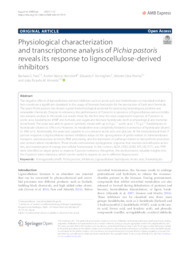Physiological characterization and transcriptome analysis of Pichia pastoris reveals its response to lignocellulose-derived inhibitors.
Physiological characterization and transcriptome analysis of Pichia pastoris reveals its response to lignocellulose-derived inhibitors.
Autoria: PAES, B. G.; STEINDORF, A. S.; FORMIGHIERI, E. F.; PEREIRA, I. S.; ALMEIDA, J. R. M. de
Resumo: The negative efects of lignocellulose-derived inhibitors such as acetic acid and furaldehydes on microbial metabolism constitute a signifcant drawback to the usage of biomass feedstocks for the production of fuels and chemicals. The yeast Pichia pastoris has shown a great biotechnological potential for producing heterologous proteins and renewable chemicals. Despite its relevance, the performance of P. pastoris in presence of lignocellulose-derived inhibitors remains unclear. In this work, our results show for the frst time the dose-dependent response of P. pastoris to acetic acid, furaldehydes (HMF and furfural), and sugarcane biomass hydrolysate, both at physiological and transcriptional levels. The yeast was able to grow in synthetic media with up to 6 g.L-1 acetic acid, 1.75 g.L-1 furaldehydes or hydrolysate diluted to 10% (v/v). However, its metabolism was completely hindered in presence of hydrolysate diluted to 30% (v/v). Additionally, the yeast was capable to co-consume acetic acid and glucose. At the transcriptional level, P. pastoris response to lignocellulose-derived inhibitors relays on the up-regulation of genes related to transmembrane transport, oxidoreductase activities, RNA processing, and the repression of pathways related to biosynthetic processes and central carbon metabolism. These results demonstrate a polygenetic response that involves detoxifcation activi ties, and maintenance of energy and cellular homeostasis. In this context, ALD4, OYE3, QOR2, NTL100, YCT1, and PPR1 were identifed as target genes to improve P. pastoris tolerance. Altogether, this work provides valuable insights into the P. pastoris stress tolerance, which can be useful to expand its use in diferent bioprocesses.
Ano de publicação: 2021
Tipo de publicação: Artigo de periódico
Unidade: Embrapa Agroenergia
Palavras-chave: Acetic acid, Furaldehydes, Komagataella phaffi, Lignocellulosic hydrolysate, Pichia pastoris, Stress tolerance
Observações
1 - Por padrão são exibidas publicações dos últimos 20 anos. Para encontrar publicações mais antigas, configure o filtro ano de publicação, colocando o ano a partir do qual você deseja encontrar publicações. O filtro está na coluna da esquerda na busca acima.
2 - Para ler algumas publicações da Embrapa (apenas as que estão em formato ePub), é necessário ter, no celular ou computador, um desses softwares gratuitos. Sistemas Android: Google Play Livros; IOS: iBooks; Windows e Linux: software Calibre.
Acesse outras publicações
Acesse a Base de Dados da Pesquisa Agropecuária (BDPA) para consultar o acervo completo das bibliotecas da Embrapa.

